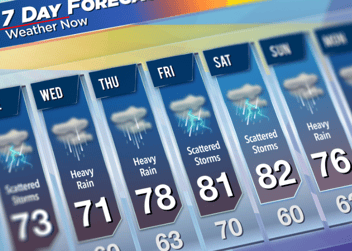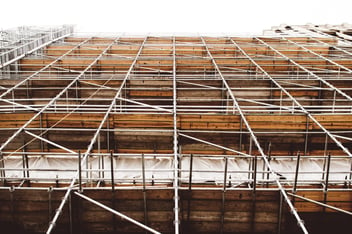Weather is one of the most common and costly causes of delay in construction — yet ironically, it’s also one of the hardest to get compensated for.
Despite a global uptick in extreme weather events, most contractors are still navigating contractual frameworks, evidentiary standards, and scheduling systems that were never designed for today’s climate realities. The result? Valid weather impacts are frequently under-claimed, contested, or rejected altogether.
This article outlines the core barriers to successful weather claims — and what’s changing in the way forward-thinking contractors are managing this risk.

1. The Contractual Catch: You May Not Be Entitled to Relief
Weather risk is not uniformly addressed in construction contracts. In fact, it’s often explicitly assigned to the contractor — even for unforeseeable events.
-
Under JCT contracts, there may be an entitlement to an extension of time for “exceptionally adverse weather conditions” — but that term is undefined and open to dispute.
-
Under the FIDIC Silver Book, typically used in EPC and turnkey projects, no weather-related relief is provided at all.
-
Under NEC contracts, early warnings and compensation events require proactive notification and are strictly time-bound.
Without clear wording, contractors are often left absorbing delays, costs, and disputes — even when weather clearly contributed.
2. Proving “Exceptional” Weather Is Increasingly Difficult
With climate extremes becoming more common, the evidentiary bar for “exceptional” weather is rising.
A contractor must show:
-
The event exceeded long-term averages or defined thresholds.
-
The event was not reasonably foreseeable based on location and time of year.
-
The weather was materially different from what could have been planned for.
Relying on regional weather station data or generic reports often falls short. Site-specific impacts — like wind speed at crane height — are rarely captured without proactive monitoring.
3. Evidence Must Be Contemporaneous, Granular, and Verifiable
To substantiate a weather claim, a contractor typically needs:
-
Localised historical and real-time weather data
-
Daily site diaries referencing specific impacted activities
-
Photographic/video evidence timestamped to the event
-
Schedule overlays that trace delays to critical path activities
The use of forecasts or summary statements alone is insufficient. Claims lacking robust, contemporaneous records are often dismissed — even if the disruption was obvious on site.

4. It’s Not Enough to Show Weather — You Must Show Delay to the Critical Path
Delays are only compensable if they directly impact the critical path. This means:
-
An activity must be weather-sensitive
-
It must be on the critical path at the time of disruption
-
The weather must have caused a delay to project completion, not just activity progress
Many contractors struggle to draw this link clearly in their documentation, especially without integrated schedule analysis tools.
5. Most Weather Claims Are Time-Only — Not Cost-Based
Even when successful, most claims only provide extensions of time — not financial compensation. To recover costs, contractors must often:
-
Demonstrate the event was not only adverse, but also compensable under the contract
-
Show resulting cost impacts were unavoidable and quantifiable
This threshold is difficult to meet, especially when poor documentation or delayed notices weaken the claim.
6. Timing and Process Are Just As Important as Evidence
Late or irregular claims are easy to reject. Many standard forms require notice within days of becoming aware of a delay — and ongoing evidence collection throughout the project.
Failing to:
-
Raise early warnings
-
Submit claims on a rolling basis
-
Track actual weather impacts as they occur can undermine an otherwise valid entitlement.
What This Means in Practice
Even with good intentions, contractors face a minefield of technical, procedural, and evidentiary hurdles:
|
Challenge |
What’s Required |
|---|---|
|
Contractual Entitlement |
Clause-based rights to time or money for weather |
|
Threshold Definition |
Proof that weather was abnormal based on site-specific historical norms |
|
Evidence Quality |
Precise, real-time site records linked to activity impacts |
|
Critical Path Proof |
Schedule analysis showing delay to project completion |
|
Timing and Notices |
Early warnings and contemporaneous claims process |
|
Compensation Basis |
Distinction between excusable (time-only) and compensable (cost + time) |

So What Can Be Done?
Weather risk is rising. Claims are getting harder. But better planning and smarter data are making a difference.
Contractors who embed site-specific thresholds, automate their recordkeeping, and link weather directly to schedules are seeing far greater success — even in adversarial contract environments.
At EHAB, we’re helping contractors do exactly that — not through a new tool to buy, but through targeted support.
If you’re struggling to:
-
Understand your entitlements under NEC, JCT, or FIDIC
-
Retrospectively assess whether weather delayed your critical path
-
Improve your evidence trail to support better negotiation
Then we’re happy to talk.
If weather delays are impacting your projects — and your ability to prove them — we’re here to help.
We’re currently providing consultation and support to contractors who want to strengthen their claims, identify missed compensation opportunities, or just get a second opinion on the risk they’re carrying.
👉 If that’s relevant to you, reach out here— no sales pitch, just a conversation.



